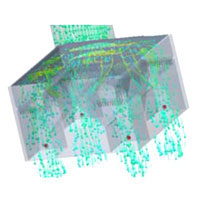Introduction
Objective
 The objective for this writing is to inform HVAC technicians and contractors about the limitations of testing equipment currently used for testing, adjusting, and balancing HVAC systems. The need for more accurate instruments is immediate as energy programs are moving toward net-zero energy building efficiencies.
The objective for this writing is to inform HVAC technicians and contractors about the limitations of testing equipment currently used for testing, adjusting, and balancing HVAC systems. The need for more accurate instruments is immediate as energy programs are moving toward net-zero energy building efficiencies.
In doing so, HVAC technicians and contractors will struggle with tighter specifications as they tune HVAC systems with instruments that fail to provide the required accuracy and versatility.
Abstract
As energy efficiency codes move toward net-zero energy buildings and building envelopes are optimized, HVAC systems will be designed to provide the minimum space heating and cooling required. Current equipment and methods used in testing, adjusting and balancing HVAC systems are not robust enough to bring HVAC systems to optimal performance. Flow hoods, being the instrument of choice to rapidly evaluate HVAC systems, fail to provide accurate flow measurements due to the influence of airflow patterns dictated by diffuser styles. This issue is not well-known in the industry; however, it causes most of the frustration experienced by technicians and contractors while tuning HVAC systems. Therefore, labor intensive and “other” methods are implemented in an effort to meet system target specifications, despite high levels of uncertainty throughout the process. The need for accurate and versatile test equipment is immediate, and new tools like the SMART Air Hood™ Balancing Instrument have the technology required to tune HVAC systems in net-zero energy buildings.
Background
Energy efficiency programs have evolved over the years due to greater involvement of utility and government agencies promoting higher energy standards for HVAC equipment. While promoting emerging technology, established manufacturers and start-up companies have revolutionized heating and cooling equipment to provide low-cost comfort in residential and commercial buildings. When designing an HVAC system, a large variety of equipment are matched, installed, and integrated in order to provide space heating and cooling within standardized efficiencies. HVAC technicians and contractors are key elements for the proper operation of HVAC equipment as they test, adjust, and balance the entire system.
Technology Snapshot
History
Flow hoods are the most popular tool used by HVAC technicians and contractors due to the versatility and ease of use for airflow measurement. However, its application has been limited due to uncertainty between the flow hood and pitot traverse airflow measurements. Therefore, flow hoods are used as indicators to proportionally balance HVAC systems. Despite the uncertainty in flow hood measurements, instrumentation manufacturers have not made any changes to the 40-year standard flow hood design.
Design Overview
The standard flow hood design is a simple concept based on the pitot traverse method that is popularly implemented in the HVAC industry for airflow measurements. Using a 3-foot long converging section, the flow hood guides airflow from a diffuser to a flow station. Pitot arrays are commonly used as flow stations, within flow hoods, to measure the airflow average velocity pressure (hence, flow rate).
The key elements in this design are the flow station and converging section of the flow hood. Ideally, the flow station accuracy should not be affected by airflow patterns as shown in Figure 1. On the other hand, the converging section should condition the airflow pattern from any diffuser style to the flow station.
Design Limitations
Test and simulation results demonstrated the following design limitations in standard flow hoods when measuring flow from different diffuser styles:
1. Pitot arrays are sensitive to airflow patterns
2. Converging sections fail to condition airflow patterns
These results correlate well to industry frustration and uncertainty while tuning HVAC systems with flow hoods. Most HVAC systems have more than one diffuser style. HVAC technicians and contractors commonly experience confusion while comparing flow hood with pitot traverse measurements when the system has different diffuser styles. A great example of this case is balancing HVAC systems in office spaces, where square diffusers with 4-way flow patterns and linear diffusers with 1-way flow patterns are commonly used. Figure 1 shows the different airflow patterns from two diffuser styles inside of a flow hood from computational fluid dynamics (CFD) analysis.
A common approach to troubleshoot the discrepancy between the return air and supply air measurements is comparing pitot traverse and flow hood measurements at the trunk or branch of the system. However, most HVAC systems:
1. Fail to provide conditions to perform a pitot traverse airflow measurement as a result of flow disturbances from elbows, tees, and flex ducting
2. Have not been leak tested
All these variables combined make tuning HVAC systems a very difficult task with the readily available testing equipment in the market.
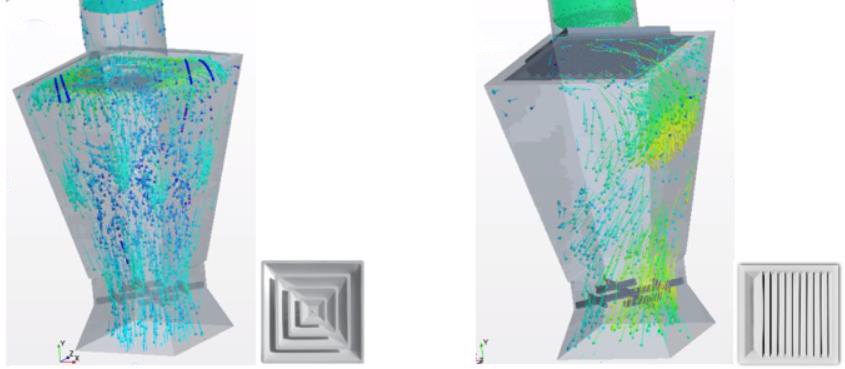
Flow Calibration Uncertainty
Until today, it was not exactly clear how standard flow hoods from different manufacturers read differently from the same diffuser style. A HVAC technician and contractor could not tell which flow hood is more accurate from comparing measurements from the same diffuser style. One reason for this inability to detect superior accuracy may be that standard flow hoods are calibrated differently. The diffuser style used in the calibration is one of the main variables that dictate the accuracy of the device. Therefore, flow hoods could only provide accurate measurements when performed with the diffuser style used in the calibration.
The Future of HVAC Regulations
Utilities and Government Agency Involvement
Using current test equipment is becoming increasingly challenging as utility and government agencies enforce higher energy efficiencies in HVAC equipment. Evidence for enforcing standards for HVAC system efficiency are:
1. Title 24 of the California Energy Efficiency Standard – duct leak testing
2. The U.S. Department of Energy – currently evaluating the compliance of tight envelopes for buildings
3. Energy Star – enforcing the compliance to building envelope leak testing
In addition to moving towards net-zero energy buildings, the U.S. Department of Health and Human Services (HHS) promotes highly regulated conditioned space rooms in hospital and government buildings via the Centers for Disease Control and Prevention (CDC). This means that HVAC technicians and contractors have to adjust HVAC systems to tighter specifications with instruments that fail to comply with the required accuracy specifications.
The Need for Emerging Technology
Energy efficiency programs are promoting complex designs and specifications for HVAC systems, which points towards the use of multi-zone, fully-controlled HVAC systems with short sealed ducting. The only way to properly calibrate a HVAC system is by having the ability to measure flow accurately. The challenges of tuning future HVAC systems include:
1. Flow hoods are not accurate enough to calibrate a HVAC system within ±5% of target specification
2. Traverse methods are ineffective as ducting becomes shorter, which limits the straight run required for flow conditioning
The problems listed above are related to the inability to measure airflow and the need for robust testing equipment. These problems also indicate that there is a gap between the HVAC emerging technology and regulations with respect to the test equipment specifications required to verify operating conditions in building installations.
Emerging Technology
Benchmark
Dwyer Instruments, Inc. has performed research testing the performance of test equipment and understanding the challenges of balancing HVAC systems using current technology. Based on the test results shown in Figure 2, Dwyer Instruments, Inc. concluded that:
1. The traditional flow hood design lacks versatility and accuracy when measuring airflow from different diffuser styles
2. There are opportunities in developing test equipment that eliminates Problems 1 and 2 listed in the section: The Future of HVAC Regulations
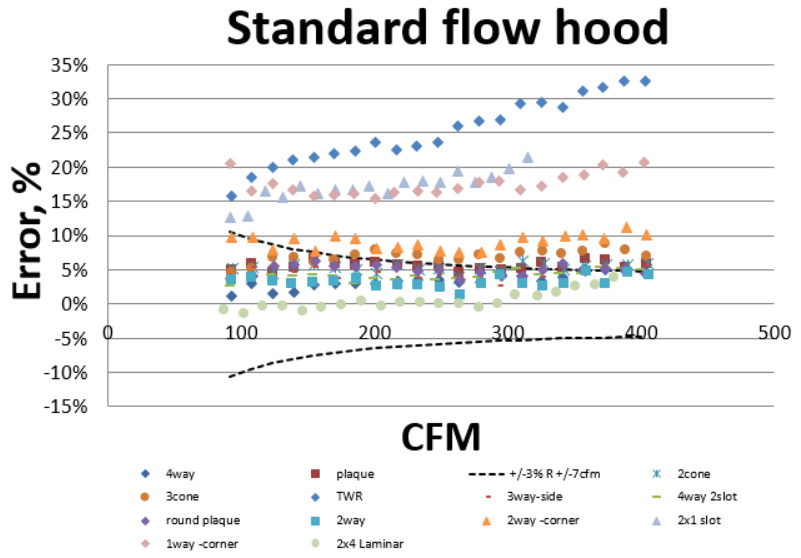
Concept
Based on Dwyer Instruments, Inc. research, the next generation of flow hoods requires calibration for every diffuser and needs to comply with the following design objectives:
1. Low weight
2. Small size
3. High maneuverability
4. High accuracy
5. Low back-pressure
Innovation
Dwyer Instruments, Inc. developed a unique flow hood, the SMART Air Hood™ Balancing Instrument, (Series SAH), understanding the limitations in current technology and the need in the market place. The SAH is a product that minimizes design objectives 1, 2 and 5 while maximizing design objectives 3 and 4 (found in the preceding subsection Concept).
Revisiting the key elements of flow hoods described in the Technology Snapshot Section, the SAH uses a smaller converging section to only direct the flow to the flow station as shown in Figure 3. Accurate flow measurements are then achieved by applying correct diffuser calibrations to flow station measurements. Test results are shown in Figure 4.

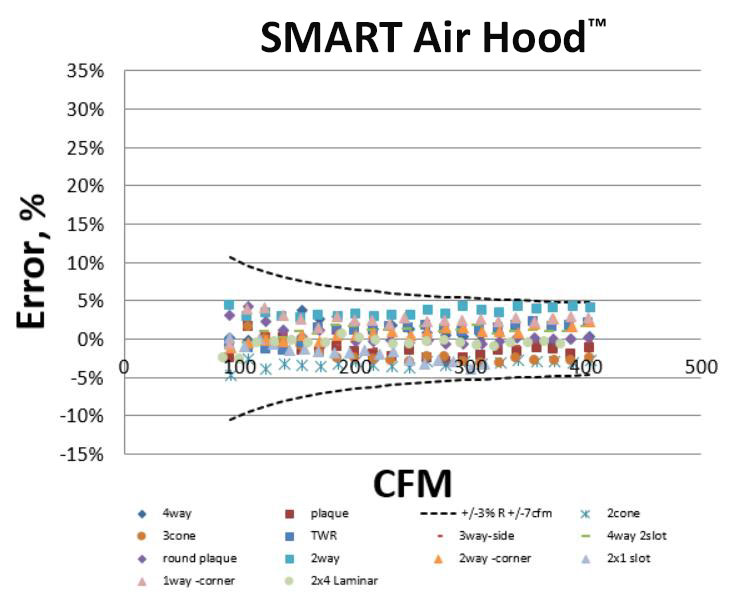
Flow Calibration
Overview
Due to design limitations 1 and 2 presented in the Technology Snapshot Section, Dwyer Instruments, Inc. understood that the future flow hood requires a set calibration factor for every diffuser. This task seemed neither feasible nor cost-effective. However, results from a statistical analysis demonstrated that any SAH could be baseline-calibrated in order to perform similarly to any other SAH in production. Therefore, the SAH could use the same diffuser calibration in any baselined-calibrated SAH.
Baseline Calibration
The baseline calibration consists of calibrating the SAH flow station velocity pressure to the SAH flow station average velocity pressure derived from a statistical analysis. This calibration process allows to zero and span the SAH flow station velocity pressure. The baseline calibration is performed in every production unit. After the baseline calibration is performed, the SAH can use any diffuser calibration to measure flow accurately from any diffuser listed in the SAH diffuser list shown in Figure 5.
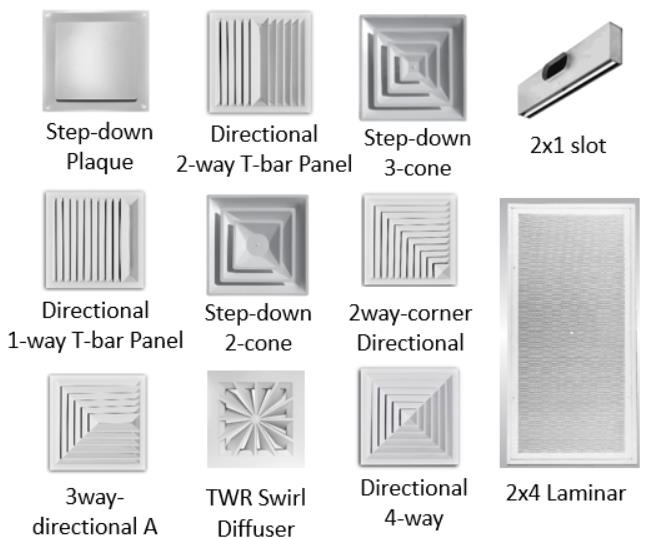
Diffuser Calibration
The diffuser calibration is a one-time event that uses a baseline-calibrated SAH unit to obtain the relationship between SAH flow station velocity pressures and flow rates at a diffuser. After a diffuser calibration is performed, the data generates the diffuser calibration factor that is used in current products.
Flow Measurement Standard
The flow measurement uncertainty described in the Technology Snapshot Section highlights a separate issue that is not well understood in the industry. Therefore, Dwyer Instruments, Inc. implements international and national standardized methods for flow measurements for the SAH calibration. Figure 6 shows the calibration flow system for the SAH production. Complying with the American Society of Mechanical Engineers (ASME) and International Organization for Standardization (ISO), Dwyer Instruments, Inc. carefully selected equipment and verified its performance. The calibration flow system instrument specifications are listed in Table 1.

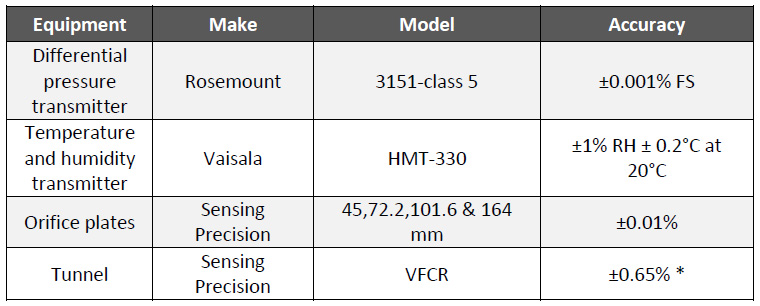
Conclusion
Optimizing HVAC Systems
The SMART Air Hood™ Balancing Instrument provides the accuracy needed for optimizing HVAC systems. By measuring flow accurately, from a large variety of diffuser styles, there is no longer a need for troubleshooting return and supply air measurements. In addition to the convenience and versatility the SAH offers HVAC technicians and contractors, there is no longer a need to search locations that meet the requirements for pitot traverse measurements.
SAH in Alignment with HVAC Regulations
While the limits of HVAC equipment and building envelope efficiencies have been optimized rapidly in the last decades, test equipment has not evolved at the same speed. Instruments readily available in the market, such as the SAH, now close the gap between the HVAC regulation efficiencies and the need for more robust test equipment.

